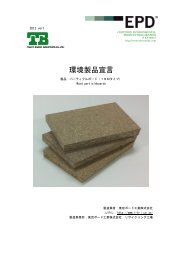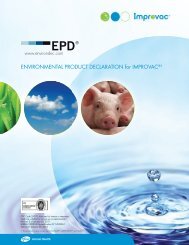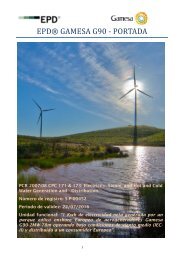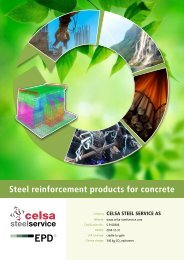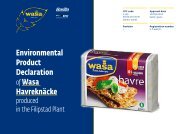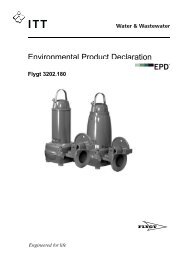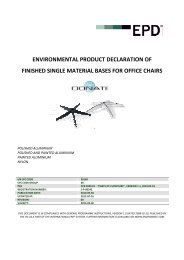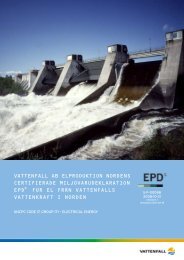Environmental Product Declaration for railway track on the Bothnia ...
Environmental Product Declaration for railway track on the Bothnia ...
Environmental Product Declaration for railway track on the Bothnia ...
You also want an ePaper? Increase the reach of your titles
YUMPU automatically turns print PDFs into web optimized ePapers that Google loves.
Railway <str<strong>on</strong>g>track</str<strong>on</strong>g><br />
<str<strong>on</strong>g>Envir<strong>on</strong>mental</str<strong>on</strong>g> <str<strong>on</strong>g>Product</str<strong>on</strong>g> <str<strong>on</strong>g>Declarati<strong>on</strong></str<strong>on</strong>g> <str<strong>on</strong>g>for</str<strong>on</strong>g><br />
<str<strong>on</strong>g>railway</str<strong>on</strong>g> <str<strong>on</strong>g>track</str<strong>on</strong>g> <strong>on</strong> <strong>the</strong> <strong>Bothnia</strong> Line<br />
Reg. no. S-P-00200 UN CPC 53212 Date 2010-03-19<br />
1
Introducti<strong>on</strong><br />
This envir<strong>on</strong>mental product declarati<strong>on</strong> (EPD) describes, from a<br />
lifecycle perspective, <strong>the</strong> total envir<strong>on</strong>mental impact of <str<strong>on</strong>g>railway</str<strong>on</strong>g><br />
<str<strong>on</strong>g>track</str<strong>on</strong>g> <strong>on</strong> <strong>the</strong> <strong>Bothnia</strong> Line. The EPD is entirely restricted to <strong>the</strong><br />
<str<strong>on</strong>g>track</str<strong>on</strong>g> system; substructure (tunnels, bridges, <str<strong>on</strong>g>track</str<strong>on</strong>g> foundati<strong>on</strong>s)<br />
and power, signalling and telecom systems are not<br />
included.<br />
Within <strong>the</strong> Internati<strong>on</strong>al EPD system based <strong>on</strong> ISO standard<br />
14025, this EPD was drawn up in accordance with <str<strong>on</strong>g>Product</str<strong>on</strong>g><br />
Category Rules (PCR) 2009:03 <str<strong>on</strong>g>for</str<strong>on</strong>g> Rail Transport and Railway<br />
Infrastructure (see www.envir<strong>on</strong>dec.com <str<strong>on</strong>g>for</str<strong>on</strong>g> fur<strong>the</strong>r in<str<strong>on</strong>g>for</str<strong>on</strong>g>mati<strong>on</strong><br />
about <strong>the</strong> EPD system).<br />
The aim of this EPD is that it should provide experts and<br />
scientists (in <strong>the</strong> c<strong>on</strong>structi<strong>on</strong> and infrastructure sectors) with<br />
objective and reliable in<str<strong>on</strong>g>for</str<strong>on</strong>g>mati<strong>on</strong> <strong>on</strong> <strong>the</strong> envir<strong>on</strong>mental impact<br />
of c<strong>on</strong>structing, operating and maintaining <str<strong>on</strong>g>railway</str<strong>on</strong>g> <str<strong>on</strong>g>track</str<strong>on</strong>g>.<br />
This EPD was developed by Botniabanan AB in cooperati<strong>on</strong><br />
with Banverket (<strong>the</strong> Swedish Rail Administrati<strong>on</strong>). It has been<br />
certified by Bureau Veritas Certificati<strong>on</strong> AB and <strong>the</strong> certificati<strong>on</strong><br />
is valid <str<strong>on</strong>g>for</str<strong>on</strong>g> three years (after which it can be prol<strong>on</strong>ged).<br />
Botniabanan AB has been resp<strong>on</strong>sible <str<strong>on</strong>g>for</str<strong>on</strong>g> <strong>the</strong> financing, detailed<br />
planning and building of <strong>the</strong> <strong>Bothnia</strong> Line. On completi<strong>on</strong>,<br />
Botniabanan AB will own <strong>the</strong> infrastructure and lease it to<br />
Banverket (<strong>the</strong> infrastructure manager). From 2050 <strong>on</strong>wards,<br />
The line has 90 <str<strong>on</strong>g>railway</str<strong>on</strong>g> bridges (total<br />
length of 11 km) and 16 tunnels (25 km<br />
of main <str<strong>on</strong>g>railway</str<strong>on</strong>g> tunnels and 16 km of serinfrastructure<br />
ownership will be transferred to Banverket. Botniabanan<br />
AB has ISO 9001:2000 (quality management), ISO<br />
14001:2004 (envir<strong>on</strong>mental management) and AFS 2001:1<br />
(work envir<strong>on</strong>ment management) certificati<strong>on</strong>.<br />
This EPD sets out <strong>the</strong> envir<strong>on</strong>mental per<str<strong>on</strong>g>for</str<strong>on</strong>g>mance of <str<strong>on</strong>g>railway</str<strong>on</strong>g><br />
<str<strong>on</strong>g>track</str<strong>on</strong>g> <strong>on</strong> <strong>the</strong> <strong>Bothnia</strong> Line. The following EPDs are also available<br />
<str<strong>on</strong>g>for</str<strong>on</strong>g> o<strong>the</strong>r <strong>Bothnia</strong> Line systems:<br />
• EPD <str<strong>on</strong>g>for</str<strong>on</strong>g> passenger transport <strong>on</strong> <strong>the</strong> <strong>Bothnia</strong> Line.<br />
• EPD <str<strong>on</strong>g>for</str<strong>on</strong>g> freight transport <strong>on</strong> <strong>the</strong> <strong>Bothnia</strong> Line.<br />
• EPD <str<strong>on</strong>g>for</str<strong>on</strong>g> <str<strong>on</strong>g>railway</str<strong>on</strong>g> infrastructure <strong>on</strong> <strong>the</strong> <strong>Bothnia</strong> Line.<br />
• EPD <str<strong>on</strong>g>for</str<strong>on</strong>g> <str<strong>on</strong>g>railway</str<strong>on</strong>g> tunnels <strong>on</strong> <strong>the</strong> <strong>Bothnia</strong> Line.<br />
• EPD <str<strong>on</strong>g>for</str<strong>on</strong>g> <str<strong>on</strong>g>railway</str<strong>on</strong>g> <str<strong>on</strong>g>track</str<strong>on</strong>g> foundati<strong>on</strong>s <strong>on</strong> <strong>the</strong> <strong>Bothnia</strong> Line.<br />
• EPD <str<strong>on</strong>g>for</str<strong>on</strong>g> <str<strong>on</strong>g>railway</str<strong>on</strong>g> bridges <strong>on</strong> <strong>the</strong> <strong>Bothnia</strong> Line.<br />
• EPD <str<strong>on</strong>g>for</str<strong>on</strong>g> power, signalling and telecom systems <strong>on</strong> <strong>the</strong><br />
<strong>Bothnia</strong> Line.<br />
As this EPD is based <strong>on</strong> data relating to <strong>Bothnia</strong> Line infrastructure,<br />
<strong>the</strong> results might not be representative of o<strong>the</strong>r<br />
<str<strong>on</strong>g>railway</str<strong>on</strong>g> <str<strong>on</strong>g>track</str<strong>on</strong>g> systems. In order to decide if <strong>the</strong> results can<br />
be representative <str<strong>on</strong>g>for</str<strong>on</strong>g> o<strong>the</strong>r <str<strong>on</strong>g>railway</str<strong>on</strong>g> <str<strong>on</strong>g>track</str<strong>on</strong>g> systems, <strong>the</strong> most<br />
important areas that should be checked to be comparable with<br />
<strong>the</strong> <strong>Bothnia</strong> Line are:<br />
• Railway functi<strong>on</strong>ality (single or double <str<strong>on</strong>g>track</str<strong>on</strong>g>, type of traffic,<br />
axle load, etc.).<br />
• C<strong>on</strong>structi<strong>on</strong> methods (e.g. ballasted or slab <str<strong>on</strong>g>track</str<strong>on</strong>g>).<br />
• Origin of materials (mainly steel and c<strong>on</strong>crete).<br />
Facts about <strong>the</strong> infrastructure<br />
of <strong>the</strong> <strong>Bothnia</strong> Line<br />
Technical Facts<br />
Infrastructure<br />
• Minimum radius of curvature:<br />
3,200 m<br />
• Maximum gradient: 10‰<br />
• Track gauge: 1,435 mm<br />
• Power supply voltage: 15 kV,<br />
16 2/3 Hz, AT system<br />
• Track: ballasted, c<strong>on</strong>crete<br />
sleepers, UIC 60 rails<br />
(c<strong>on</strong>tinuous welded)<br />
• Signalling system: ERTMS<br />
level 2<br />
• Maximum axle load: 25 t<strong>on</strong>nes<br />
(30 t<strong>on</strong>nes <strong>on</strong> bridges)<br />
2<br />
The <strong>Bothnia</strong> Line is a new Swedish <str<strong>on</strong>g>railway</str<strong>on</strong>g><br />
running from Nyland (north of Kram<str<strong>on</strong>g>for</str<strong>on</strong>g>s)<br />
to Umeå. It is routed via Örnsköldsvik and<br />
comprises 190 km of new single-<str<strong>on</strong>g>track</str<strong>on</strong>g><br />
<str<strong>on</strong>g>railway</str<strong>on</strong>g> with 22 sidings (each 1 km l<strong>on</strong>g)<br />
and 7 travel centres/stati<strong>on</strong>s. The latter<br />
have good c<strong>on</strong>necti<strong>on</strong>s <str<strong>on</strong>g>for</str<strong>on</strong>g> pedestrians,<br />
cyclists, local and regi<strong>on</strong>al bus traffic and<br />
private vehicles. There is a large freight<br />
terminal in Umeå and a smaller c<strong>on</strong>tainer<br />
terminal in Örnsköldsvik.<br />
vice and access tunnels). Designed <str<strong>on</strong>g>for</str<strong>on</strong>g> combined passenger<br />
and heavy freight traffic, <strong>the</strong> <strong>Bothnia</strong> Line offers maximum<br />
speeds of 250 km/h <str<strong>on</strong>g>for</str<strong>on</strong>g> passenger trains and 120 km/h <str<strong>on</strong>g>for</str<strong>on</strong>g><br />
freight trains with a maximum axle load of 25 t<strong>on</strong>nes. The<br />
groundbreaking <str<strong>on</strong>g>for</str<strong>on</strong>g> <strong>the</strong> project took place <strong>on</strong> 14 August 1999<br />
and <strong>the</strong> <str<strong>on</strong>g>railway</str<strong>on</strong>g> will become operati<strong>on</strong>al in autumn 2010.<br />
Total <str<strong>on</strong>g>track</str<strong>on</strong>g> length (sidings included)<br />
is 209 km. The <str<strong>on</strong>g>track</str<strong>on</strong>g> was built using<br />
a l<strong>on</strong>g rail (420 m) system and is<br />
c<strong>on</strong>tinuous welded (CWR). Sleepers<br />
are c<strong>on</strong>crete with a c/c distance<br />
of 60 cm and class 1 macadam<br />
ballast. There are 125 points <strong>on</strong><br />
<strong>the</strong> line, all with heating and snow<br />
brushes.<br />
Locati<strong>on</strong> of <strong>the</strong> <strong>Bothnia</strong> Line.
<str<strong>on</strong>g>Envir<strong>on</strong>mental</str<strong>on</strong>g> per<str<strong>on</strong>g>for</str<strong>on</strong>g>mance<br />
Resource use and emissi<strong>on</strong>s<br />
The envir<strong>on</strong>mental per<str<strong>on</strong>g>for</str<strong>on</strong>g>mance secti<strong>on</strong> of <strong>the</strong> declarati<strong>on</strong> is<br />
based <strong>on</strong> a lifecycle assessment (LCA) carried out by IVL Swedish<br />
<str<strong>on</strong>g>Envir<strong>on</strong>mental</str<strong>on</strong>g> Research Institute in 2009. An overview of<br />
system boundaries and included processes is given in <strong>the</strong> text,<br />
figures and tables below.<br />
Extracti<strong>on</strong> and producti<strong>on</strong> of raw materials, transport of<br />
materials and manufacturing of products were included in <strong>the</strong><br />
LCA calculati<strong>on</strong>s. The data in respect of infrastructure-related<br />
processes and quantities of materials was collected from <strong>the</strong><br />
building of <strong>the</strong> <strong>Bothnia</strong> Line. As regards steel <str<strong>on</strong>g>for</str<strong>on</strong>g> rails, specific<br />
data <str<strong>on</strong>g>for</str<strong>on</strong>g> material producti<strong>on</strong> was used. For o<strong>the</strong>r materials,<br />
selected generic data was used according to <strong>the</strong> calculati<strong>on</strong><br />
rules in <strong>the</strong> PCR 2009:03. The electricity used in c<strong>on</strong>structi<strong>on</strong><br />
processes and <str<strong>on</strong>g>for</str<strong>on</strong>g> producti<strong>on</strong> of materials was calculated as<br />
<strong>the</strong> average electricity mix <str<strong>on</strong>g>for</str<strong>on</strong>g> <strong>the</strong> countries hosting <strong>the</strong> processes.<br />
The LCA calculati<strong>on</strong>s are based <strong>on</strong> a calculati<strong>on</strong> period of 60<br />
years. This means that <strong>the</strong>y include all c<strong>on</strong>structi<strong>on</strong>, operati<strong>on</strong><br />
and maintenance processes assumed to take place in that<br />
time. All results are presented per kilometre of <str<strong>on</strong>g>railway</str<strong>on</strong>g> <str<strong>on</strong>g>track</str<strong>on</strong>g><br />
(main line).<br />
Point machine<br />
Ballast<br />
Rail<br />
Sleepers<br />
Fasteners<br />
All processes and elements needed to c<strong>on</strong>struct, operate and maintain <strong>the</strong> <str<strong>on</strong>g>railway</str<strong>on</strong>g> <str<strong>on</strong>g>track</str<strong>on</strong>g> system have been included in <strong>the</strong> LCA. However,<br />
note that substructure (tunnels, bridges, <str<strong>on</strong>g>track</str<strong>on</strong>g> foundati<strong>on</strong>s) and power, signalling and telecom systems are not included. The figure<br />
shows some of <strong>the</strong> most important structural elements.<br />
Overview of processes and elements included in <strong>the</strong> LCA<br />
<str<strong>on</strong>g>for</str<strong>on</strong>g> <str<strong>on</strong>g>railway</str<strong>on</strong>g> <str<strong>on</strong>g>track</str<strong>on</strong>g> <strong>on</strong> <strong>the</strong> <strong>Bothnia</strong> Line.<br />
Track Track Track<br />
c<strong>on</strong>structi<strong>on</strong> operati<strong>on</strong> maintenance<br />
Rail Switch heating Reinvestments<br />
determined by<br />
lifetimes of<br />
comp<strong>on</strong>ents and<br />
c<strong>on</strong>structi<strong>on</strong>s<br />
Sleepers and Operati<strong>on</strong> of Rail grinding<br />
fasteners<br />
point machines<br />
Ballast<br />
Illuminati<strong>on</strong> of<br />
<str<strong>on</strong>g>railway</str<strong>on</strong>g> depots<br />
Point machines<br />
C<strong>on</strong>structi<strong>on</strong> work<br />
Welding<br />
Rail grinding<br />
As, under <strong>the</strong> rules in PCR 2009:03, waste handling<br />
processes make a negligible c<strong>on</strong>tributi<strong>on</strong> to envir<strong>on</strong>mental<br />
impact categories (
<str<strong>on</strong>g>Envir<strong>on</strong>mental</str<strong>on</strong>g> impact of 1 km of <str<strong>on</strong>g>railway</str<strong>on</strong>g> <str<strong>on</strong>g>track</str<strong>on</strong>g> (main line) <strong>on</strong> <strong>the</strong> <strong>Bothnia</strong> Line. All c<strong>on</strong>structi<strong>on</strong>, operati<strong>on</strong> and maintenance<br />
activities over 60 years are included <str<strong>on</strong>g>for</str<strong>on</strong>g> <strong>the</strong> <str<strong>on</strong>g>track</str<strong>on</strong>g> infrastructure. However, note that substructure, power, signalling and<br />
telecom systems are not included.<br />
Impact category unit c<strong>on</strong>structi<strong>on</strong> Operati<strong>on</strong> Maintenance Total<br />
Resource use<br />
N<strong>on</strong>-renewable materials kg 4 482 301 1 825 5 919 180 10 403 306<br />
Renewable materials kg 5.8 0 7.6 13<br />
N<strong>on</strong>-renewable energy MJ 3 732 000 24 444 5 028 678 8 785 122<br />
Renewabe energy MJ 173 467 12 977 486 229 855 13 380 808<br />
Recycled resources kg 28 421 0 37 642 66 063<br />
Water kg 3 680 399 0 4 891 978 8 572 377<br />
Land use m 2 1 973 20 200 2 609 24 781<br />
Emissi<strong>on</strong>s<br />
Global warming kg CO 2<br />
equivalents 389 845 3 118 522 967 915 930<br />
Acidificati<strong>on</strong> kg SO 2<br />
equivalents 585 23 779 1 387<br />
Oz<strong>on</strong>e depleti<strong>on</strong> kg CFC-11 equivalents 0.000030 0 0.000040 0.000070<br />
POCP (Photochemical<br />
oxidant <str<strong>on</strong>g>for</str<strong>on</strong>g>mati<strong>on</strong>) kg e<strong>the</strong>ne equivalents 55 2.0 72 129<br />
Eutrophicati<strong>on</strong><br />
3-<br />
kg PO 4<br />
equivalents 125 4.3 165 293<br />
O<strong>the</strong>r<br />
Ouput of materials<br />
<str<strong>on</strong>g>for</str<strong>on</strong>g> recycling kg 393 0 209 364 209 757<br />
Waste, hazardous kg 377 0 501 878<br />
Waste, excess soil kg 0 0 0 0<br />
Waste, o<strong>the</strong>r kg 18 322 191 886 066 904 578<br />
Specificati<strong>on</strong> of resources making <strong>the</strong><br />
largest c<strong>on</strong>tributi<strong>on</strong>s to <strong>the</strong> different<br />
resource use categories<br />
Resource use Largest<br />
category c<strong>on</strong>tributors<br />
Solid rock: 91.0%<br />
Sand and gravel: 3.2%<br />
N<strong>on</strong>-renewable Ir<strong>on</strong>: 3.2%<br />
materials Limest<strong>on</strong>e: 2.5%<br />
Renewable<br />
materials Wood: 100%<br />
Coal: 54.4%<br />
Crude oil: 22.1%<br />
N<strong>on</strong>-renewable Natural gas: 17.7%<br />
energy Nuclear: 5.8%<br />
Renewabe Hydro power: 98.1%<br />
energy Biomass fuel: 1.9%<br />
Wind power: 0.1%<br />
Recycled Ferrous scraps: 100%<br />
resources<br />
4
Dominance analysis<br />
100%<br />
90%<br />
80%<br />
70%<br />
60%<br />
50%<br />
40%<br />
30%<br />
20%<br />
10%<br />
0%<br />
Global<br />
warming<br />
Addificati<strong>on</strong> Oz<strong>on</strong>e layer<br />
depletiom<br />
POCP<br />
Eutrophicati<strong>on</strong><br />
De<str<strong>on</strong>g>for</str<strong>on</strong>g>estati<strong>on</strong><br />
Infrastructure operati<strong>on</strong><br />
Infrastructure material transport<br />
Infrastructure c<strong>on</strong>structi<strong>on</strong> work<br />
Infrastructure material<br />
Emissi<strong>on</strong> impact categories and <strong>the</strong> relative c<strong>on</strong>tributi<strong>on</strong>s (in %) made by<br />
<strong>the</strong> process groups relevant to <strong>the</strong> <strong>Bothnia</strong> Line’s <str<strong>on</strong>g>railway</str<strong>on</strong>g> <str<strong>on</strong>g>track</str<strong>on</strong>g>. The process<br />
groups include all activities during <strong>the</strong> calculati<strong>on</strong> period of 60 years. For<br />
example, “Infrastructure material” covers all materials used during c<strong>on</strong>structi<strong>on</strong>,<br />
maintenance and reinvestment.<br />
Infrastructure material = Emissi<strong>on</strong>s from raw material acquisiti<strong>on</strong> and producti<strong>on</strong><br />
of materials such as steel, c<strong>on</strong>crete, etc.<br />
Infrastructure c<strong>on</strong>structi<strong>on</strong> work = Emissi<strong>on</strong>s from machines (trucks, locomotives,<br />
etc.) used in c<strong>on</strong>structing <strong>the</strong> infrastructure.<br />
Infrastructure material transport = Emissi<strong>on</strong>s from vehicles (e.g. trucks and<br />
trains) used <str<strong>on</strong>g>for</str<strong>on</strong>g> transporting infrastructure material (e.g. sleepers and rails) from<br />
suppliers to <strong>the</strong> c<strong>on</strong>structi<strong>on</strong> site.<br />
Infrastructure operati<strong>on</strong> = Emissi<strong>on</strong>s from producti<strong>on</strong> of electricity used <str<strong>on</strong>g>for</str<strong>on</strong>g><br />
operati<strong>on</strong> of <strong>the</strong> infrastructure (e.g. switch heating).<br />
De<str<strong>on</strong>g>for</str<strong>on</strong>g>estati<strong>on</strong> = Net emissi<strong>on</strong>s of CO2 resulting from <str<strong>on</strong>g>for</str<strong>on</strong>g>est land being permanently<br />
changed to <str<strong>on</strong>g>railway</str<strong>on</strong>g> land. Not applicable <str<strong>on</strong>g>for</str<strong>on</strong>g> <str<strong>on</strong>g>railway</str<strong>on</strong>g> <str<strong>on</strong>g>track</str<strong>on</strong>g>.<br />
5
Additi<strong>on</strong>al envir<strong>on</strong>mental in<str<strong>on</strong>g>for</str<strong>on</strong>g>mati<strong>on</strong><br />
The impact that <strong>the</strong> building and operati<strong>on</strong> of <strong>the</strong> <strong>Bothnia</strong> Line<br />
has <strong>on</strong> land use, biodiversity and envir<strong>on</strong>mental risk-related<br />
issues has been analysed and is described in <strong>the</strong> three EPDs<br />
regarding passenger transport, freight transport and infrastructure.<br />
However, it is not possible or relevant to relate <strong>the</strong><br />
results of <strong>the</strong> impact analyses to <strong>the</strong> individual infrastructure<br />
elements. C<strong>on</strong>sequently, this EPD c<strong>on</strong>tains no such details.<br />
Recycling declarati<strong>on</strong><br />
The main infrastructure elements that are relevant as regards<br />
waste management and recycling in <strong>the</strong> calculati<strong>on</strong> period (60<br />
years) are <str<strong>on</strong>g>track</str<strong>on</strong>g>, power, signalling and telecom equipment. O<strong>the</strong>r<br />
elements such as <str<strong>on</strong>g>track</str<strong>on</strong>g> foundati<strong>on</strong>s, bridges and tunnels<br />
are not to be replaced during <strong>the</strong> calculati<strong>on</strong> period. Within<br />
Banverket, <strong>the</strong>re is currently no general nati<strong>on</strong>al strategy <str<strong>on</strong>g>for</str<strong>on</strong>g><br />
recycling materials that are replaced during maintenance.<br />
Such materials often become <strong>the</strong> property of <strong>the</strong> c<strong>on</strong>tractor.<br />
Banverket’s envir<strong>on</strong>mental strategy c<strong>on</strong>tains <strong>the</strong> following<br />
prioritised goals <str<strong>on</strong>g>for</str<strong>on</strong>g> <strong>the</strong> future:<br />
• Development, from an envir<strong>on</strong>mental perspective, of l<strong>on</strong>g--<br />
term reutilisati<strong>on</strong> plans <str<strong>on</strong>g>for</str<strong>on</strong>g> strategic materials.<br />
• Development of envir<strong>on</strong>mentally sound and effective management<br />
procedures <str<strong>on</strong>g>for</str<strong>on</strong>g> prioritised categories of waste.<br />
6<br />
Management of materials and substances<br />
Throughout <strong>the</strong> c<strong>on</strong>structi<strong>on</strong> of <strong>the</strong> <strong>Bothnia</strong> Line, all c<strong>on</strong>tractors<br />
have, as regards any chemical products and potentially<br />
envir<strong>on</strong>mental harmful materials <strong>the</strong>y use, been required to<br />
obtain <strong>the</strong> approval of Banverket’s Chemicals Board. Ano<strong>the</strong>r<br />
requirement has been that PVCs and certain o<strong>the</strong>r materials<br />
(a number of specified harmful substances included <strong>the</strong>rein)<br />
must not be used be<str<strong>on</strong>g>for</str<strong>on</strong>g>e <strong>the</strong> c<strong>on</strong>tractor has made an envir<strong>on</strong>mental<br />
risk assessment and Botniabanan AB has agreed with<br />
<strong>the</strong> use. If <strong>the</strong> use of any of <strong>the</strong>se substances could not be<br />
avoided, <strong>the</strong> locati<strong>on</strong> of <strong>the</strong> comp<strong>on</strong>ents c<strong>on</strong>taining <strong>the</strong> substances<br />
has been documented by <strong>the</strong> c<strong>on</strong>tractor.<br />
The satisfacti<strong>on</strong> of <strong>the</strong>se requirements has been checked in<br />
audits of all major c<strong>on</strong>tractors.<br />
Hazardous waste generated in all c<strong>on</strong>tracts <str<strong>on</strong>g>for</str<strong>on</strong>g> <strong>the</strong> building of<br />
<strong>the</strong> <strong>Bothnia</strong> Line has been collected in envir<strong>on</strong>mental stati<strong>on</strong>s<br />
supplied by Botniabanan AB and managed by companies accredited<br />
<str<strong>on</strong>g>for</str<strong>on</strong>g> management of hazardous waste.
Hissjö<br />
E4<br />
key<br />
<strong>the</strong> bothnia line<br />
Tunnel<br />
bridge<br />
sidings (double-<str<strong>on</strong>g>track</str<strong>on</strong>g>)<br />
goods yard<br />
new secti<strong>on</strong>, <strong>the</strong> ådal line<br />
new <str<strong>on</strong>g>railway</str<strong>on</strong>g> (banverket)<br />
roads<br />
existing <str<strong>on</strong>g>railway</str<strong>on</strong>g><br />
rebuilt existing <str<strong>on</strong>g>railway</str<strong>on</strong>g><br />
county/provincial boundary<br />
municipal boundary<br />
92<br />
0 5 10 km<br />
Bjurholm<br />
Vännäs<br />
E12<br />
Sör<str<strong>on</strong>g>for</str<strong>on</strong>g>s<br />
Travel centre<br />
umeå C<br />
Brännland<br />
Umeälven<br />
Umeå<br />
Umeå City<br />
Airport<br />
Umeå<br />
flygplats<br />
Stöcksjö<br />
E4<br />
Stöcke<br />
Travel centre<br />
umeå east<br />
E12<br />
Obbola<br />
Holmsund<br />
Sörmjöle<br />
STAMBANAN<br />
Nyåker<br />
Öreälven<br />
Travel centre<br />
hörne<str<strong>on</strong>g>for</str<strong>on</strong>g>s<br />
Nordmalings kommun<br />
Umeå kommun<br />
Hörnån<br />
Ängersjön<br />
Hörne<str<strong>on</strong>g>for</str<strong>on</strong>g>s<br />
Norr<str<strong>on</strong>g>for</str<strong>on</strong>g>s<br />
Travel centre<br />
nordmaling<br />
Håknäs<br />
Ledån<br />
Olofs<str<strong>on</strong>g>for</str<strong>on</strong>g>s<br />
Västerbottens län<br />
Trehörningsjö<br />
Lögdeälven<br />
Nordmaling<br />
Västernorrlands län<br />
Lögdeå<br />
Rundvik<br />
Långviksm<strong>on</strong><br />
Nordmalings kommun<br />
Örnsköldsviks kommun<br />
Saluån<br />
Ava<br />
Saluböle<br />
Route and travel centres/stati<strong>on</strong>s <strong>on</strong><br />
<strong>the</strong> <strong>Bothnia</strong> Line (tunnels and bridges<br />
also shown).<br />
Gideå<br />
Husån<br />
E4<br />
Björna<br />
Travel centre<br />
husum<br />
Grundsunda<br />
Örnsköldsviks<br />
flygplats<br />
Örnsköldsvik<br />
Airport<br />
Gideälven<br />
Kasa<br />
Husum<br />
Lill Mosjön<br />
Moälven<br />
Travel centre<br />
örnsköldsvik n<br />
Arnäs<br />
Bredbyn<br />
Mellansel<br />
Moliden<br />
MoTravel centre<br />
örnsköldsvik c<br />
Själevad<br />
Örnsköldsvik<br />
Domsjö<br />
STAMBANAN<br />
Skorped<br />
Sidensjö<br />
Drömme<br />
Bjällsta<br />
Hinnsjön<br />
Drömmesjön<br />
Kornsjösjön<br />
Nätraån<br />
Bjästa<br />
Köpmanholmen<br />
Örnsköldsviks kommun<br />
Sollefteå kommun<br />
Stor Degersjön<br />
Örnsköldsviks kommun<br />
Kram<str<strong>on</strong>g>for</str<strong>on</strong>g>s kommun<br />
E4<br />
Gålsjö Bruk<br />
Leån<br />
Docksta<br />
Boteå<br />
Styrnäs<br />
Ullånger<br />
Mjällom<br />
ollefteå<br />
Sollefteå kommun<br />
Kram<str<strong>on</strong>g>for</str<strong>on</strong>g>s kommun<br />
90<br />
Kram<str<strong>on</strong>g>for</str<strong>on</strong>g>s<br />
flygplats<br />
Kram<str<strong>on</strong>g>for</str<strong>on</strong>g>s<br />
Airport<br />
Nyland<br />
Bollstabruk<br />
Väja<br />
Sandslån<br />
ÅDALSBANAN<br />
Bjärtrå<br />
Travel centre<br />
kram<str<strong>on</strong>g>for</str<strong>on</strong>g>s<br />
Ångermanälven<br />
Herrskog<br />
Nora<br />
Nordingrå<br />
Kram<str<strong>on</strong>g>for</str<strong>on</strong>g>s<br />
Lunde<br />
Klockestrand<br />
E4<br />
Ramvik<br />
Höga Kustenbr<strong>on</strong><br />
EPDs from different programmes may not be comparable<br />
See www.botniabanan.se <str<strong>on</strong>g>for</str<strong>on</strong>g> more in<str<strong>on</strong>g>for</str<strong>on</strong>g>mati<strong>on</strong> <strong>on</strong> <strong>the</strong> EPD and <str<strong>on</strong>g>for</str<strong>on</strong>g><br />
background material.<br />
Utansjö<br />
PCR review was c<strong>on</strong>ducted by <strong>the</strong> Technical Committee (TC) of <strong>the</strong><br />
Internati<strong>on</strong>al EPD C<strong>on</strong>sortium (IEC).<br />
See www.envir<strong>on</strong>dec.com <str<strong>on</strong>g>for</str<strong>on</strong>g> more in<str<strong>on</strong>g>for</str<strong>on</strong>g>mati<strong>on</strong> and c<strong>on</strong>tact <str<strong>on</strong>g>for</str<strong>on</strong>g> IEC.<br />
Independent verificati<strong>on</strong> of <strong>the</strong> declarati<strong>on</strong> and data, according to<br />
ISO 14025:<br />
Internal<br />
Third party verifier:<br />
x external<br />
Bureau Veritas Certificati<strong>on</strong> AB<br />
Fabriksgatan 13 · SE-412 50 Göteborg SWEDEN<br />
Layout: Byrå09, Örnsköldsvik Print: Ågrenshuset Produkti<strong>on</strong>, Bjästa<br />
8



